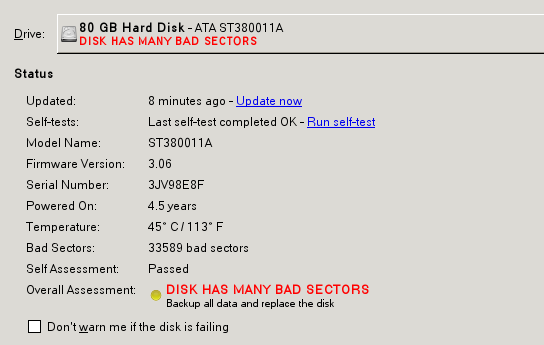เพิ่งได้อ่านหนังสือ CHIP (ที่ทำงาน เป็นสมาชิกรายปี) ประจำเดือนพฤศจิกายน 2552 มีเรื่องทดสอบ Windows 7 – Mac OS X – kubuntu ว่าใครกันแน่เยี่ยมที่สุด .. จริงๆ ขึ้นว่า CHIP ไม่ต้องอ่านก็เดาได้ว่า CHIP จะให้ใครเยี่ยมที่สุด โดยเฉพาะช่วงเปิดตัวระบบปฏิบัติการของไมโครซอฟต์ แต่อยากดูว่าจะเอาเหตุอะไรมาเป็นผลว่าเยี่ยมที่สุดบ้าง อ่านไปก็คิดไปว่า อืมม นะ .. quote ประโยคจากหนังสือมาให้ดูสักหน่อย
ในช่วงหกเดือนที่ผ่านมา ไมโครซอฟต์อุดช่องโหว่ด้านความปลอดภัยไปแล้วถึง 39% ของช่องโหว่ทั้งหมดที่ตรวจพบ ส่วนแอปเปิ้ลทำได้ 18% และลินุกซ์ทำได้เพียง 14%
คำว่า “ทั้งหมดที่ตรวจพบ” ควรจะเปลี่ยนเป็น “ทั้งหมดที่ไมโครซอฟต์ -ยอมรับว่า- เป็นช่องโหว่” เพราะตัวเลขมันไม่เท่ากัน .. และ สถิติในปี 2009 ของ Secunia ซึ่งทำมาหากินกับเรื่อง security คงจะเห็นแย้งไปจากที่ CHIP พยายามบอก
ไมโครซอฟต์ตอบสนองด้วยการอัปเดตแพตช์แก้ไขได้รวดเร็วกว่าคู่แข่งทั้งสอง … กำหนดทุกวันอังคารที่สองของเดือนเป็น patch day แอปเปิ้ล ลินุกซ์ ไม่มีกำหนดเวลาแน่นอน
patch day หนึ่งวันต่อเดือนนี่ถือเป็นมาตรการที่ช่วยให้เร็วแล้วหรือ ? จากที่ secunia แทร็ก Windows 7 มา 2 เดือน เจอ 4 vulnerabilities เป็น remote exploit 100% และยังแก้ไม่เสร็จ นี่เร็วแล้วหรือ ? และ ใช่ ลินุกซ์ไม่มีกำหนดแน่นอน เพราะมันไม่ต้องกำหนดแน่นอน มันออกแพตช์ได้ทุกชั่วโมง หรือสั้นกว่านั้น และไม่ว่ามันเป็น critical หรือไม่ ถ้ามันได้รับการแก้ไขมันแล้วก็ออกแพตช์ได้ทันทีโดยไม่ต้องรอจนถึงรอบการอัปเดต
Kubuntu ไม่มีระบบตรวจสอบหรืออัปเดตอะไรทั้งสิ้น ผู้ใช้จะต้องคอยตรวจสอบข่าวสารจากเว็บไซต์ และทำการอัปเดตแพตช์ด้วยตัวเองแบบแมนนวล
ไม่ได้ใช้ apt ? และใน /etc/cron.daily/apt ตั้งไว้ให้เช็คอัปเดตอัตโนมัติทุกวัน และเวลาอัปเดตเสร็จแล้วก็ไม่ต้อง reboot ใหม่ทุกครั้งเหมือน Windows :P
ในขณะที่ลินุกซ์นั้น ผู้ใช้จะสามารถอัปเดตแพตช์หลังจากที่มีการตรวจสอบช่องโหว่ครั้งแรกเพียงแค่ไม่กี่ชั่วโมงเท่านั้น (แต่ความรวดเร็วนี้บางครั้งก็ส่งผลต่อเสถียรภาพของระบบด้วยเช่นกัน)
ความล่าช้าของไมโครซอฟต์ก็ไม่ได้แปลว่ามันไม่มีปัญหาเรื่องเสถียรภาพ จะใส่วงเล็บหลังข้อความไปทำไม ? จงใจ mislead ?
Kubuntu หากผู้ใช้ต้องการความปลอดภัยก็จะต้องหาไฟร์วอลล์มาติดตั้งเพิ่มเติมด้วยตัวเอง
iptables มีมาพร้อมกับลินุกซ์แทบทุก distro และถ้า CHIP ยังไม่รู้ .. มันคือไฟร์วอลล์
Windows 7 ให้การปกป้องได้ดีที่สุด … ถ้าจะพิจารณาจากฟีเจอร์การป้องกันที่ Windows 7 มีให้ อย่างน้อยก็ถือว่าวมันเป็นระบบปฏิบัติการที่สามารถยืนหยัดและต่อกรกับแฮกเกอร์ในปัจจุบันได้ดีที่สุด ส่วนผู้ไช้ Mac OS X และ Kubuntu นั้นจะต้องคอยระวังตัวมากเป็นพิเศษเนื่องจากไม่มีไฟร์วอลล์และระบบป้องกันไวรัส อีกทั้งยังต้องคอยตรวจสอบแพตช์ด้วยตัวเองอีกด้วย
แม่เจ้า … Windows 7 มีช่องโหว่ตั้งแต่ alpha/beta เป็นช่องโหว่เดียวกับ XP/Vista ซึ่งเก่ากว่าหลายปี ไม่นับว่ามีช่องโหว่ที่ metasploit ยิงทีเดียวร่วง ตั้งแต่ก่อนจะ Release to Manufac. (RTM) ด้วยซ้ำ และที่ไมโครซอฟต์ต้องขนสารพัดระบบมาป้องกันตัว ก็เพราะมันจำเป็นต้องมี และ ณ เวลานี้ต่อให้มีก็ยังไม่พอจะทำให้ Windows 7 อยู่รอดปลอดภัยได้ .. ในขณะที่ OS อื่นไม่จำเป็นมากเท่า Windows 7 ส่วนหนึ่งเพราะไม่ใช่เป้าโจมตี และอีกส่วนหนึ่งเพราะมันปลอดภัยพอจะเอาตัวรอดได้โดยไม่ต้องพึ่งพาไฟร์วอลล์หรือป้องกันไวรัส
[Core 2 Duo 2.93 GHz ..] Cold Start Windows 7 ใช้เวลา 26 วินาที Mac OS X 28 วินาที Kubuntu 43 วินาที … ReadyBoost นั้นจะช่วยเพิ่มความเร็วในการทำงานของระบบให้สูงขึ้นอีกด้วยการนำไฟล์ที่ใช้บ่อยๆ ไปเก็บไว้ในแฟลชไดรฟ์ยูเอสบีที่มีอัตราในการอ่านข้อมูลโดยเฉลี่ยสูงกว่าฮาร์ดดิสก์
แปลก .. MacBook C2D 2.1 T7200 ฮาร์ดดิสก์โน้ตบุ๊ค 5400RPM Cold Start Ubuntu เสร็จภายในเวลา < 20 วินาที และเท่าที่ มีคนทำ bootchart ไว้ คือ 5 วินาที บน P8600 + SSD และถ้าไม่จำกัดที่ K/Ubuntu มี Linux LiveCD ยังใช้เวลา boot ไม่ถึง 10 วินาที
Kubuntu กลับทำได้น่าผิดหวัง ทั้งนี้ต้องตำหนิระบบการเข้าถึงทรัพยากรและซีพียูที่ไม่มีประสิทธิภาพของมัน … การก๊อปปี้ไฟล์จำนวน 1,239 ไฟล์ ขนาด 4.21 GB Kubuntu ใช้เวลานาน 2.12 นาที Windows 7 1.58 นาที Mac OS X 1.44 นาที
จริง .. default file system (Ext3) นับว่าช้าเมื่อเทียบกับ file system อื่นอีกหลายตัวที่มีในลินุกซ์ และ higher-level VFS ของ KDE/GNOME ก็เป็นตัวถ่วงได้อีก ถ้าต้องการให้เร็วกว่านี้ก็เปลี่ยน file system ได้ และไปใช้คำสั่งในคอมมานด์ไลน์แทน .. อีกด้านหนึ่ง Windows 7 ขณะก๊อปปี้ไฟล์ ใช้ I/O มากๆ UI ยังตอบสนองได้ปกติไหม ? ขยับเมาส์ได้หรือเปล่า ? :P
ไฟล์วิดีโอ HD … ทั้งนี้ระบบปฏิบัติการรุ่นใหม่ๆ จะมีการจัดสรรการใช้พลังงานอย่างเหมาะสมและมีการใช้ประโยชน์จาก GPU เพื่อช่วยประมวลผลข้อมูลบางชนิด เช่น วิดีโอ … Windows 7 จะใช้พลังประมวลผลของซีพียูเพิ่มขึ้นแค่ 16% ส่วน Mac OS X และ Kubuntu ทำให้ซีพียูทำงานเพิ่ม 22% และ 33% ตามลำดับ
เรื่องนี้ default ยอมแพ้ .. แต่ถ้ามี hyperthread / multicore ใช้ mplayer-mt ลดพลังประมวลผลได้ประมาณ 30% หรือมากกว่า .. หรือถ้ามีการ์ด NVIDIA ใช้ mplayer + VDPAU … ทั้งหมดนี้ขึ้นกับว่าจะ code ให้ใช้ฟีเจอร์พวกนี้หรือเปล่า ไม่มีระบบปฏิบัติการไหน – รวมถึง Windows 7 – มี system call ที่ใช้ GPU และ/หรือ playback video .. ดังนั้นมันไม่ได้เกี่ยวกับระบบปฏิบัติการนักหรอก
Kubuntu จะมาพร้อมกับเครื่องมือแบ็กอัพแบบง่ายๆ ซื่งไม่สามารถทำ Shadow Copy ของไฟล์ได้เลย
ใช้ NILFS2 ทำ continuous snapshot ได้ และอาจจะดีกว่า volume snapshot อย่าง Shadow Copy
หากรายชื่อจองโปรแกรมไม่ปรากฏขึ้นมาใน Program Manager … วิธีเดียวที่จะติดตั้งโปรแกรมได้จะต้องทำผ่านคอมมานด์ไลน์เท่านั้น
มะเหงก โหลด *.deb แล้ว double click ที่ icon ก็ได้
การติดตั้งอุปกรณ์ฮาร์ดแวร์เพิ่มเติมลงในระบบถือเป็นงานที่ง่ายและแทบไม่มีปัญหาใดๆ สำหรับ Windows 7 เพราะมันจะมาพร้อมกับฐานข้อมูลไดรเวอร์สำหรับอุปกรณ์เกือบทุกชนิด
คอมพิวเตอร์หลายเครื่องยังไม่ได้อัปเกรดเป็น Windows 7 ก็เพราะมันไม่มีไดรเวอร์นี่แหละ และเครื่องที่ว่าบูต Ubuntu ใช้งานแบบ LiveCD ได้
ส่วน Kubuntu นั้นมาพร้อมกับไดรเวอร์มาตรฐานเพียงเล็กน้อยเท่านั้น นอกจากนี้การค้นหาไดรเวอร์เฉพาะสำหรับอุปกรณ์บางอย่างยังเป็นเรื่องที่สำบากมาก และผู้ใช้ที่จะสามารถติดตั้งอุปกรณ์ใหม่ๆ ลงในระบบและใช้งานได้คงจะมีแต่ผู้เชี่ยวชาญลินุกซ์เท่านั้น
อีกด้านหนึ่ง ก็เพิ่งจะได้อ่านจาก GNOME Journal ว่า เด็กหญิงอายุห้าขวบที่ยังอ่านหนังสือไม่ออก กับพี่ชายอายุหกขวบที่เพิ่งอ่านหนังสือออก ช่วยกันติดตั้ง Ubuntu ได้เองโดยไม่มีใครคอยแนะนำ สนใจอ่านต่อได้ที่ The Un-Scary Screwdriver
Kubuntu ไม่มี Encryption
มี และทำได้หลายเลเยอร์
Kubuntu ไม่มี Antispyware
เพราะไม่จำเป็นต้องมี อย่างน้อยก็เวลานี้ และถ้าต้องการก็ติดตั้ง chkrootkit, rkhunter พอได้
Kubuntu พื้นที่สำหรับการติดตั้ง 10 GB
เพราะมันเป็น distro ไม่ใช่ OS มันเลยมีแอพพลิเคชันติดตั้งมาด้วย (อย่างน้อยก็ +OO.o, GIMP, …) และที่จริงใช้ไม่เกิน 4 GB.. อย่ามั่ว
Kubuntu ไม่มี System Security
ไม่ค่อยเข้าใจว่าคืออะไร แต่ถ้าหมายถึง Security Center ที่ไมโครซอฟต์พยายามผูกเป็นส่วนหนึ่งของ system สำหรับระบบปฏิบัติการอื่นมันไม่ใช่สิ่งที่ต้องมี
Kubuntu ไม่มี System Acceleration (e.g. ReadyBoost)
เพราะไม่ต้องมีก็เร็วได้
Kubuntu ไม่มีการแสดงรายละเอียดของไดรเวอร์
lshw, lsmod,lspci, lsusb, dmesg, /proc, ….
อืมม .. นะ .. IMHO .. CHIP (Thailand) อวยขนาดนี้ก็น่าเกลียดเกินไปหน่อย ถ้าทำไปด้วยความเขลาขนาดนี้ก็น่าเวทนา หรือถ้าแกล้งเขลาก็น่าอาย .. และนิตยสารแบบนี้ น่าเสียดายเงิน
.. blog บ่น ก็ยาวอย่างนี้แหละ :P







